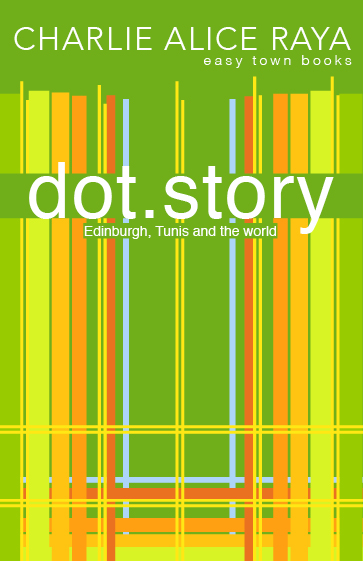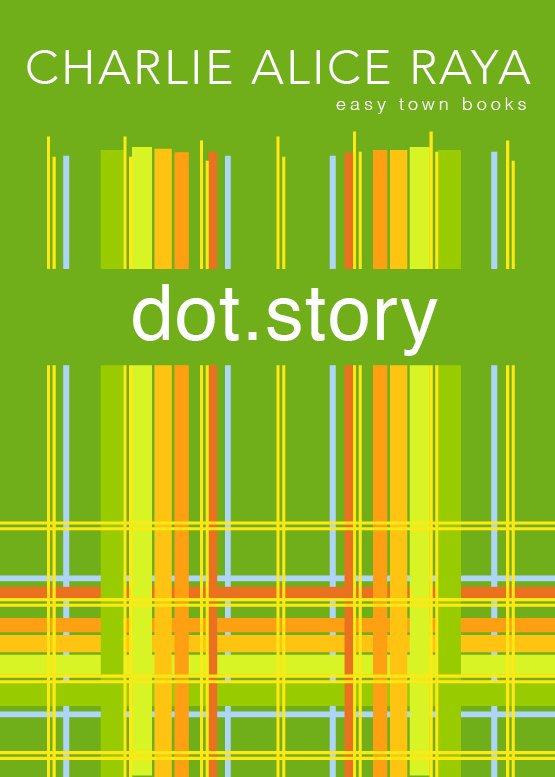preview, dot.story

dot.story
/// 7 October ///
dot.designer 1
Leathan, Edinburgh, Scotland
Leathan, a young fashion designer from Edinburgh, registered with dot.international at the beginning of September, answering all the questionnaires, meeting with some dot.people at the local dot.station, and showing them samples of his work, a three days marathon he had prepared for the previous two months.
Years ago, on his first day at the design academy, he heard about dot. And that day he decided that working with dot. was what he wanted to do.
He never wavered in his decision, but after graduation he felt that he was still too young to commit, and he knew that he wasn’t as good as he wanted to be. So he decided to travel for two years. But after only five months, he returned to Edinburgh, and applied to become a dot.designer, pointing out that he was aware of his youth, but that he didn’t have the patience to postpone his calling any longer, and that dot. was still the only company he wanted to work with. He also pointed out that he lived in a small rented flat, always went by bicycle, was single with no ambitions to change that, and generally lived on very little. So it would be OK if he only earned little in the first years. But he was sure that he could contribute something.
The weeks following his application were dreadful. Leathan withdrew into his small flat, living of frozen pizza, and binge watching just about anything his streaming service offered. Never before had he doubted that he had a place at dot. But now, with every new day that passed, his doubts grew. And he dreaded the moment when dot. might tell him that he was out.
A week into October dot.’s answer finally arrived.
A letter of acceptance.
Part of Leathan just wanted to run down to his local pub and celebrate. But the letter contained a lot of additional information, and once he logged into the dot.network, and saw what it had to offer, he forgot all about the pub. Well, for some hours. To be exact, until he read something about dot.’s research into what people actually need in their wardrobes.
It was then that Leathan called his mates to join him on a pub crawl in the Old Town. Not just for fun, but to do some research. Though, Leathan wasn’t so much interested in what people might need, instead he wanted to find out what people might want in their wardrobes.
Luckily just before Leathan left his flat, he looked into the mirror, recoiled, took a shower, shaved his red beard off and dressed in a white button shirt he hadn’t worn in years. It was the only clean shirt left. His jeans needed a wash, but it would have to do for tonight.
Looking like a human again, Leathan left his flat in a hurry and met up with his mates in Cockburn Street.
They had a lot of fun — and a lot to drink. And a few times, Leathan was glad that Edinburgh Castle, which sat towering above the city, always reassured him that he wasn’t lost yet.
By the end of the night, stumbling home, Leathan had filled half a notebook with what people wanted, and interestingly, what people would like to wear but couldn’t find in any shop.
The next day, nursing a massive hangover, Leathan set to work. But after some hours, he got lost in a mountain of ideas.
A bit uncertain whether he should contact the dot.research team this soon after joining dot., he contacted them nonetheless, sent them his notes, and asked them whether they had any input on the issues brought up by the night revellers in Edinburgh, and could they tell him how other people went about their ideas when there were too many of them, all at once?
Having sent the email, Leathan decided to clean his flat, and three hours later, he took his washing to the local laundrette.
On the way, he made notes for clothes that wouldn’t need to be washed, or at least not often.
/// 8 October ///
dot.research
Likun, based at the dot.headquarters near Tunis
Likun from the Yi people in Lijiang, China, smiled when she read the email sent by a designer based in Edinburgh. Likun knew moments like this when so many ideas swirl through your mind that you had no idea where to start, and the longer you looked at the swirl the more it turned into a threatening cloud that was about to engulf you, because there was no way in the world that you could have the time or the resources to work on all ideas in a single lifetime.
After thinking a little, Likun talked to her colleague Bjarte who had joined dot. from Ringsaker in Norway. Together they did some research, and the next day they sent an answer to Leathan in Edinburgh.
/// 9 October ///
dot.designer 1
Leathan, Edinburgh, Scotland
Leathan laughed when he read the email by Likun and Bjarte, and he did a little dance. The researchers had not only brought structure to his ideas, they had added suggestions, some calculations and statistics, and contacts to designers and fabrics creators, plus a list with exercises to help him relax and clear his mind.
The researchers also pointed out that as a dot.designer Leathan could create single items, a collection, or items which fit into an existing collection. This meant he didn’t have to translate every idea into a full collection.
In a way, Leathan’s ideas had gotten bigger, but they weren’t a big mass anymore. Now his ideas were like ripe cherries on a cherry tree, and all Leathan had to decide was which cherry to pick.
Leathan wiped tears off his face, smiling happily. The darkness of the previous weeks was still hovering at the back of his mind, but this was great.
Leathan noticed that one of the suggested designers was a local, Calli, living on Queen Street in the New Town.
Bjarte’s note about her sounded ambiguous. ‘Calli is a bit of an old grump. But she is excellent. And she might be interested in meeting you.’
/// 11 October ///
dot.stations team
Lakeshia, based at the dot.headquarters near Tunis
Lakeshia leaned back in her chair and looked out of the windows, smiling. They had really done it. They had created a dot.station plus dot.headquarters embedded in nature, almost immersed in nature, plants winding around every building and taking up much of the space on the ground. Butterflies, bees and birds added more colours and life to the scene.
On the edge of the winding roof garden, opposite Lakeshia’s building, a peacock surveyed its surroundings, turning its head here and there.
The peacock reminded Lakeshia of her grandmother who had had peacocks and the most beautiful garden in their village by the sea, north-west of Tunis. Her grandmother would have loved this place. Well, the rope bridges, installed to give more room to nature, were a bit wobbly, but most people liked them, and wheelchair drivers used the chair lifts to cross from one building to another.
The building team’s task had been nothing short of gigantic: build a dot.station with space for all sorts of extensions, not just for the local community but also as a test base for other dot.stations. Then find a way to add the dot.headquarters, and while you are at it, integrate everything you do into a natural environment that lives and breathes, and add spaces that are of particular value to this region.
And they had done it. It had taken them nearly four and a half years, but last Friday they celebrated the completion of the final building stage.
The headquarters were divided into clusters of buildings. Each main team had their own cluster with buildings ranging from one to five floors. Those clusters were connected to hubs where different teams had spaces for cooperation. Some headquarter buildings were in the north of the dot.station, others were integrated into the dot.station, sitting side by side with dot.workshops, and using some of the same facilities, like the restaurants, chill-out areas, gardens, shops or the library.
What Lakeshia also liked was that the building team had found a good balance between buzzing spaces and quiet spaces. No matter where in the dot.station you were, it was always easy to find a spot in a garden or on a terrace where you could take a moment to rest or think, before you went back into the buzz.
Maybe Lakeshia’s regard for quiet spots had to do with her upbringing. In her childhood the villagers had been close, but there had been tensions, too. One day, those tensions escalated, and it was her grandmother’s speech that put an end to the fights.
Lakeshia was too young to remember every word, but one piece of advice was etched into Lakeshia’s memory. ‘If rage threatens to overcome you, then you turn and run until you are outside the village and on your own. And then you take a deep breath and put up a fight against your rage. You only come back to the village when you are a master of yourself again!’
Today, Lakeshia was usually calm, very likely thanks to her many runs out of the village, and the many fights she put up against her rage when she was young. But she still valued a quiet spot where she could take a moment to think.
Her favourite spot was in The Body Garden next to the sculpture of a brain made of climbing plants. There she sometimes ran into Jamshad, her husband. He headed the dot.research team for workplaces, which was practical, because it meant that they could work together at times.
They grew up together, studied at the same university, and then they went their separate ways for two years to make sure that they really wanted to spend the rest of their lives together.
Lakeshia used the time to travel from Casablanca to Beirut. Jamshad travelled from Port Said to Cape Town. And one day, they would take the journey along the West African coast together.
When they met again, they spent many days and nights comparing notes and rediscovering each other, and then they married a few days before they joined dot.
They had been undecided whether to have children, but by now they were sure that their energies were best spent on this project.
That they could work in Tunisia was a bonus. They had both enjoyed travelling, but Tunisia was home. And Lakeshia wasn’t sure she could ever be really happy anywhere else.
Lakeshia knew that the initial dot.team had chosen the outskirts of Tunis as the location for the dot.headquarters for several reasons.
Firstly, it had been decided that Aotearoa New Zealand would be offered the first dot.city. This was why the initial dot.team wanted the dot.headquarters to be kind of on the opposite side of the globe. After all, it was one of dot.’s principles to let as many regions as possible benefit from dot.business opportunities.
Secondly, the initial dot.team wanted a location that was kind of central to different parts of the world: Africa, the Arab World and Europe.
Thirdly, they wanted access to the sea to encourage visitors to arrive via boat or train rather than to fly.
Fourthly, the Tunisian government granted the dot.station autonomy so long as dot. could prove that its presence improved the quality of life in this region.
Lakeshia chuckled. Quality of life can mean different things to different people, and the initial dot.team clarified that they were talking about health, creative and empowering work, gardens, education and arts, not about cars, gold, high rises or tech gadgets. To which the main governmental negotiator replied: ‘Good. We have no shortage of the other kind of artists.’
Smiling at the memory, Lakeshia looked at the peacock again. It was exploring the roof garden now, walking slowly, and occasionally searching the ground with its beak.
Still smiling, she turned away from the window and turned on her computer.
Lakeshia was the head of the dot.stations team, a team who kept an eye on all dot.stations worldwide, and who extended the network. It was a fantastic job, but …
Lakeshia picked up the folder for the Edinburgh dot.station, and the three Edinburgh dot.workshops. The trouble was that the dot.station didn’t get as much work as anticipated. It opened three years ago, but the numbers still didn’t add up. Theoretically they could close one of the dot.workshops. But no one wanted to do that — yet. There were some who said that the dot.station only needed to be extended further to offer more for visitors — maybe a theatre. Though, when Lakeshia told René about that idea, René laughed.
René was a friend and a member of the dot.collections team, who had joined dot. from Taranto in Italy.
‘Another theatre?’ René exclaimed still laughing. ‘In Edinburgh? Don’t you know anything about that great city? Home to the largest theatre festival in the world? The Fringe?’
The Fringe. Lakeshia browsed her emails. Likun from the research team had forwarded her an email exchange with a promising new designer in Edinburgh. And some of his ideas had a connection to the Fringe.
She found his email and the relevant paragraphs. He wrote: ‘Usually someone living in Edinburgh dreads the festival time in August when the city swells over with people from around the world. No, it’s more like those festival people take over the city — and that for a whole month. So I was thinking, maybe we could have a special festival collection for locals. Like something that makes us stick out of the mass but which is also celebratory. After all the festivals are pretty cool — all considered. And then I thought we could also have special collections for festival goers, like for each festival something that shows: Oh, look that nb is going to the Film Festival, and that duda is on her way to the Fringe, that couple is obviously all-in at the Arts Festival, and over there that group is heading to the Book Festival, and so on. But I’m not talking uniform. I’m talking something they have in common, you know like a clan pattern, something you recognise but that can be used in different ways or in combinations, and you still know who is who. But it’s about having fun with those outfits, and about having something to remember this time by, it’s not about dividing people. In fact, someone who goes to several of the festivals could mix the outfits. And of course it should be something that can be used afterwards. And you know, someone who decides to come to the Fringe, they plan their visit months in advance, so they can order their Fringe outfit in time, and it waits for them on arrival.’
Lakeshia looked out of the window again. The peacock was gone, replaced by two people who were discussing something while pacing up and down the roof garden.
A dot.station didn’t have to make money all the time. If it could make money during the festival time, then the dot.station could focus on supporting the community between the festivals. And maybe this idea could be extended to include theatre companies. Why not make theatre companies an offer for their costumes? Though those would be produced at their local dot.workshops. But that was good too. And couldn’t they offer something like work clothes for artists, like a training outfit for dancers, or a painter’s coat with extra pockets for brushes and colours?
/// 12 October ///
dot.digital
Alex, based at the dot.headquarters near Tunis
Alex, who had joined the dot.international team from Portland, Oregon, US, added three new fashion designers to the network, from Riyadh, Hamburg and Lima. This included setting up a profile for each designer, a digital vault for all design specifications and photos, an account for all financial transactions, a special page for communications with dot.workshops regarding orders, another page for communications with other members of the network regarding creative questions, and a third communications space for questions and suggestions regarding research and innovations. The page all designers loved most was the world map page which showed them where items from their collections were in production or already sold.
Next Alex added five new raw materials suppliers. They were from Borneo, Germany, Eritrea, Algeria and the US. Their set-up was pretty similar to that of the designers. The major difference was that all suppliers were integrated into the network system. This system matched dot.raw materials suppliers with dot.materials producers, and the dot.producers with dot.workshops.
A lot of the data in the system was kept up to date automatically, but suppliers and workshops could add additional data such as when and how much they wanted to work for dot., what kind of materials or skills they specialised in, or how regional cost factors might influence the prices they could offer.
Alex called the suppliers from Algeria and Germany to get some more information about their staff and about the state of their machinery. The German supplier, Sophie, was a shy sounding woman from near Dresden, who seemed to take offence when Alex asked about her machinery. It took a while to convince Sophie that this wasn’t about patronising or charity. This was about strengthening the network and making sure that each part of the network had what it needed.
In the end and still suspicious, Sophie agreed to a visit from a dot.supplier expert who was based at the dot.station in Leipzig.
Before her lunch break, Alex took a look at the designers she had recently added. She was always curious about their first steps, their first designs.
Alex smiled. Sebastian from her hometown Portland had uploaded the first pieces of his ordinary-kids collection, Leathan from Edinburgh had already contacted the research team, and Juana from Montevideo would meet with a local dot.photographer in two weeks. Juana was a well established creator who had been offered to promote designs from her nearly forty years of work. And since the photo shoots were scheduled for a whole week, it looked like she was going to do just that.
/// 14 October ///
dot.designer 2
Juana, Montevideo, Uruguay
Juana sneezed.
And her son Jose cursed. ‘Mama, do we really have to unpack all your old— oh, wow, this is cool. When did you do this?’
‘Oh, I had forgotten about it. I call it the blue river. I did it when I was in my mid-twenties. Back then, for me, everything had to flow. I didn’t want any clothes stuck to my body, so I designed extra large shirts and trousers, and these rivers.’
Jose, who was in his early twenties, slipped into the flowing robe and whirled around a few times, and sneezed. ‘It’s beautiful. But it’s all so dusty.’
Some hours later, Benita, a dot.photographer, visited Juana.
They wouldn’t do any photos today, just look at the pieces Juana had selected, and discuss where to take the photos, and which models and lights to use.
Late that night, Juana sat alone in her patio, drinking a glass of red wine.
She felt strange about the last weeks.
At first it had been a bit of a joke to contact dot. She had wanted to know whether they were all words, or whether they actually meant what they said, which included: it doesn’t matter where you are from, what age, gender, background or constitution you have. If you agree with our general principles, and if your work has the kind of quality we want for our customers, then you are in.
And now she was.
In.
And this In had pushed her to take a trip into the past. Her past. The past of her work.
She found many pieces she had forgotten about. Some pieces were really bad, superficial, kind of empty. But others were really good.
These old pieces were also witnesses to her life. She wondered whether she could communicate this. Like, if you want to feel like someone who opposed mini skirt and tight jeans in her twenties, then this is your ticket.
Or should she let the customers, the future wearers, decide what this or that outfit might mean to them? Without any reference to her?
In her twenties, her teacher Georgina told her: ‘Darling, you’re too much in love with your work. You have to let it go. Let it have a life of its own. Don’t dictate how people should see it.’
Juana put down her glass of wine.
Back then and now, she retorted: ‘But I want them to know!’
/// 16 October ///
dot.designer 1
Leathan, Edinburgh, Scotland
The first time Leathan met Calli she was reserved, testing him, she told him at their second meeting. Today, Leathan picked Calli up for another walk in the Princes Street Gardens.
Calli was great and grumpy and grey-haired and beautiful and an original. What was more, she liked his ideas, had worked on some similar ideas, and sometimes she even smiled.
Today, she didn’t talk at all until they reached the gardens. Then she gave the looming Edinburgh Castle a critical look, sighed and said: ‘You know, boy, I’ve been thinking we should make this more sustainable. I like our festival ideas and your What’s missing ideas, but so far all these ideas are too good.’
‘Too good?’
‘Yes, it’s obvious. Everyone will want to buy our designs. But the buyers will only wear the festival outfits for some days, and then it’s moths fodder and more waste on the planet. Look, I’ve been meaning to visit Gerald. He’s one of our local dot.raw materials suppliers. And even though he’s from London and has big ideas, and is a bit full of himself, he’s learning, and he’ll be a good guy given time, and given some more poking.’
dot.story
© Charlie Alice Raya
CHARLIE ALICE RAYA
dot.story
Edinburgh, Tunis and the world
A story illustrating the ideas for dot.
e-book
dot.story
268 pages, 69k words
dot.appendix
77 pages, 13k words
2 files pdf files, optimised for mobile phone & tablet
- dot.story & appendix
- dot.tour
ISBN 978-3-9821289-1-7


